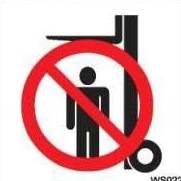Worker injured by fallen forklift carriage and tines
In February 2023, a worker was seriously injured when he was trapped by a fallen forklift carriage and tines. Early investigations found he was carrying out maintenance work on the front of a five tonne forklift. It appears the carriage and tines were raised above the worker unsupported, when for reasons yet to be confirmed they fell, striking and trapping him.
These findings are not yet confirmed, and investigations are continuing into the exact cause.
Safety issues
Forklifts are a practical material handling solution but they are also one of the most hazardous workplace vehicles. People working with or around them often become complacent because they can be quiet, used frequently and are often part of a busy work environment. Incidents involving forklifts are usually serious and often fatal.
Forklift maintenance should follow a regular schedule of services, preventative repairs, inspections and cleaning as set out in the forklift’s operational manual. Maintenance procedures can be included as part of a safety management system.
Examples of risks when maintaining forklifts:
- Instability: The forklift can unexpectedly tip over, for example when carrying an uneven load or attempting to move a load larger than its capacity.
- Speed and stopping distances: applying the brakes inappropriately can cause the forklift to tip forward or lose its load.
- Falling objects: incorrectly supported loads can tip and fall from the forklift tines. In some cases, it is recommended to secure the load to the tines (check forklift or attachment manuals for the recommended lifting technique).
- Suspended load: suspended loads (or raised tines) can drop, especially when no restraints are used or where lift force is lost (e.g. loss of hydraulic pressure/power occurs or fracture of a lifting part).
Ways to manage health and safety
Taking steps to manage risks is a condition of doing business in Queensland. Effective risk management starts with a commitment to health and safety from those who manage the business. If an incident occurs, you'll need to show the regulator you’ve used an effective risk management process. This responsibility is covered by your primary duty of care in the Work Health and Safety Act 2011.
Use the hierarchy of controls to help decide how to eliminate and reduce risks in your place of work. The hierarchy of controls ranks types of control methods from the highest level of protection and reliability to the lowest. It’s a step-by-step approach to eliminating or reducing risks. You must work through the hierarchy of controls when managing risks with the aim of eliminating the hazard, which is the most effective control.
Possible control measures to prevent similar incidents
Business owners must ensure the provision and maintenance of safe plant. Higher order risk controls include designing plant to eliminate risks to health and safety.
It’s important to operate a forklift safely and create a safe work environment to minimise the risk of incidents. The risk of forklift-related injuries can also be reduced by making sure employees are well trained, and machinery is well maintained.
Maintaining forklifts
Forklifts should be regularly inspected and maintained according to the manufacturer's instructions.
Use qualified inspectors and repairers
- Use only a trained, qualified person to inspect, maintain or repair forklifts. Use only licensed gas fitters to repair and/or replace parts on LP gas-powered forklift.
- Use only qualified tyre fitters to remove and fit tyres.
- Use only a qualified person to inspect and assess damage, and do not use an unsafe or damaged forklift until the qualified person has rendered it safe and removed the tags.
- Develop maintenance procedures.
- Do not allow anyone to stand, work or walk under raised tines.

- Keep detailed records of every inspection, service, maintenance, repair and modification carried out on a forklift. Record dates, names of authorised people involved, and meter readings.
- Establish a procedure for dealing with unsafe or damaged forklifts. The procedure should include isolating and tagging the vehicle and reporting the problem to the appropriate person.
Keep forklifts clean
- Keep the forklift clean, so it’s easier to detect worn or defective parts.
- Clean with water, not flammable liquids.
- Document full details of damage (for example, the cause and type of damage, repairs required and assessment of the vehicle's safety. Include a copy of this in the inspection and maintenance records).
- Establish and maintain procedures to make sure the spark arrestor tank on the exhaust line of a diesel forklift is maintained according to recommendations of the flameproofing company.
For more information, see the forklift maintenance factsheet (PDF, 0.35 MB) and forklift safety guide (PDF, 0.27 MB).
Before operating a forklift
- Complete a pre-operational check by following the manufacturer's instructions in the forklift manual.
- Report any damage or problems to their supervisor immediately.
- Follow the manufacturer's or employer's procedures.
- Remove the key and tag out unsafe forklifts to prevent unauthorised use.
More information on forklift safety can be found in the links below.
More information
- Forklifts
- Managing risks of plant in the workplace code of practice 2021 (PDF, 1.57 MB)
- Managing the risk of falls at workplaces code of practice 2021 (PDF, 3.9 MB)
- How to manage work health and safety risks code of practice 2021 (PDF, 0.65 MB)
- Forklift safety for employers: maintenance (PDF, 0.35 MB)
- Forklift safety for workers (PDF, 0.38 MB)
- Forklift safety – reducing the risks guide (PDF, 0.27 MB)
- Understanding a forklift's load capacity (PDF, 0.41 MB)
- Using forklift attachments (PDF, 0.34 MB)
Have you been affected by a workplace fatality, illness or serious injury?
For advice and support: